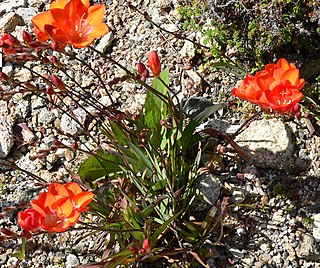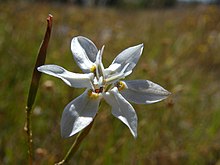
Sparaxis is a genus of flowering plants called the harlequin flowers. It belongs to the iris family Iridaceae with about 13 species endemic to Cape Province, South Africa.

Freesia is a genus of herbaceous perennial flowering plants in the family Iridaceae, first described as a genus in 1866 by Christian Friedrich Ecklon (1886) and named after the German botanist and medical practitioner, Friedrich Freese (1795–1876). It is native to the eastern side of southern Africa, from Kenya south to South Africa, most species being found in Cape Provinces. Species of the former genus Anomatheca are now included in Freesia. The plants commonly known as "freesias", with fragrant funnel-shaped flowers, are cultivated hybrids of a number of Freesia species. Some other species are also grown as ornamental plants.

Gladiolus is a genus of perennial cormous flowering plants in the iris family (Iridaceae).

Ixia is a genus of cormous plants native to South Africa from the family Iridaceae. Some of them are known as the corn lily. Some distinctive traits include sword-like leaves and long wiry stems with star-shaped flowers. It usually prefers well-drained soil. The popular corn lily has specific, not very intense fragrance. It is often visited by many insects such as bees. The Ixia are also used sometimes as ornamental plants. The genus is endemic to the Cape Provinces of western South Africa.

Watsonia is a genus of plants in the family Iridaceae, subfamily Crocoideae. Watsonias are native to southern Africa. The genus is named after Sir William Watson, an 18th-century British botanist.
The Koninklijke Algemeene Vereniging voor Bloembollencultuur, translated from Dutch as the Royal General Association for Bulb Culture, but more commonly known world-wide by the acronym of KAVB, is a trade association for the bulb horticulture sector, and was established in 1860. The association has a rural organization, within which regional groups and departments are active.

Tritonia is a genus of flowering plants in the iris family first described as a genus in 1802. They are naturally distributed across southern Africa, with a high concentration of species in Cape Province of western South Africa. The genus is closely related to the genus Ixia.

Romulea is a genus of flowering plants in the family Iridaceae, first described as a genus in 1772. It is found in Europe, the Mediterranean, the Arabian Peninsula, and Africa.

Aristea is a genus of evergreen, perennial and rhizomatous species of flowering plants in the family Iridaceae, first described in 1789. The genus is distributed in tropical and southern Africa, as well as Madagascar. The genus name is derived from the Greek word arista, meaning "awn".

Hesperantha is a genus of cormous flowering plants in the family Iridaceae. The genus name is derived from the Greek words hesperos, meaning "evening", and anthos, meaning "flower".

Tritoniopsis is a genus of flowering plants in the family Iridaceae, first described as a genus in 1926. The entire genus is endemic to Cape Province in South Africa. The genus name refers to the African genus Tritonia and is combined with the Greek word opsis, meaning "look-alike".

Lapeirousia is a genus in the plant family Iridaceae. It is endemic to sub-Saharan Africa, about a third of the species occurring in fynbos.





















